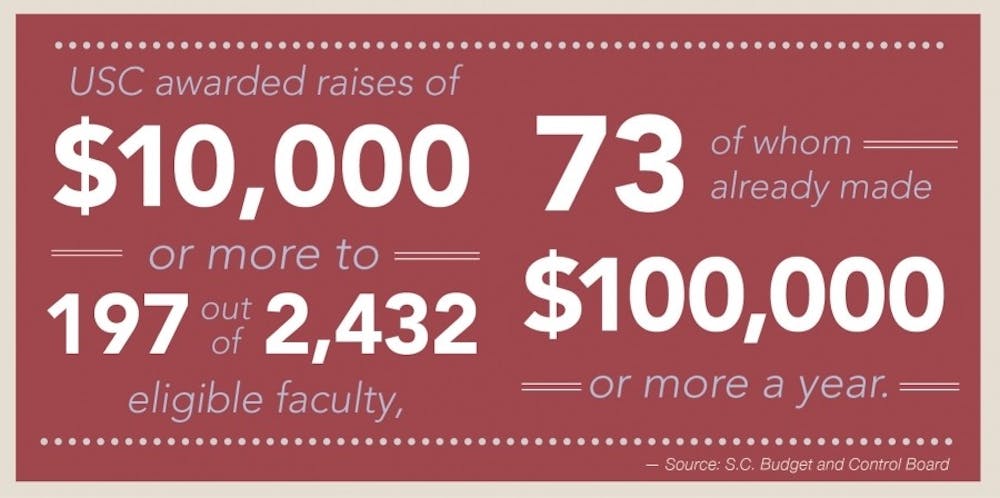Pastides: Recovering economy, added roles justify salary increases
For years, USC got by without giving raises.
Faculty and administrators didn’t expect pay increases in the depths of the recession, USC President Harris Pastides said. Other universities and businesses weren’t hiring, so USC’s top talent was content to stay put.
But as the economy lumbers toward a full recovery, they’ve begun to receive competing offers, and in the coming years, the university will need to give more frequent raises across the board to keep them here, Pastides said.
“It’s not that certain that other institutions aren’t raiding, aren’t recruiting, aren’t giving raises, and that’s when people ... will look up and get a call or an offer,” Pastides said.
The latest such raise came this year, as the state legislature mandated a 3 percent raise for all state employees. It was the first across-the-board raise for USC employees since 2008, according to Chris Byrd, USC’s vice president for human resources.
Last year, employees earning under $100,000 per year received a one-time bonus of 1.5 percent.
Still, Pastides said, many administrators and faculty took on additional roles, or they otherwise needed more pay to stay in Columbia.
The result: USC handed out raises well above the state-mandated 3 percent, with some top administrators receiving upwards of 20 percent more money this year, according to analysis of data provided by the S.C. Budget and Control Board under an open records request.
For many, raises translated to tens of thousands of dollars in increased pay.
Less than a tenth of the faculty eligible for a raise this year got $10,000 or more in additional pay — 197 of 2,432 employees, according to the data. 73 of them already earned $100,000 or more.
They include:
—Tom Vogt, an associate vice president for research, received a pay raise of $43,810 (23.1 percent), taking his overall pay to $233,810.
—Prakash Nagarkatti, the vice president for research, got $42,411 (18.3 percent) more, bringing his salary to $273,980.
—Terry Parham, USC’s general counsel, saw his pay increase to $258,137 with a $34,370 (15.4 percent) raise.
—Dennis Pruitt, the vice president for student affairs, pulled down $30,860 (13.3 percent) more, taking his salary to $262,896.
For others, this year wasn’t the first time they’d gotten a raise in recent years.
Ed Walton, USC’s chief financial officer, received a $43,542 (18.5 percent) raise this year, taking his salary to $279,542 after getting a $72,000 (43.9 percent) increase last year. Leslie Brunelli, an associate vice president for finance, earned $23,926 (12.3 percent) more, making her salary $218,926, up from 155,639 in 2010. Byrd, the vice president for human resources, made $31,150 (17.3 percent) more, increasing his salary to $211,150, up from $124,230 in 2010.
The Daily Gamecock’s analysis compared the Budget and Control Board’s data for employees’ salaries as of Aug. 31 in those years.
This semester, Mary Anne Fitzpatrick, the dean of the College of Arts and Sciences, received an additional $25,000 in pay when she was named a vice provost, taking her salary to $310,897.
And earlier this month, the board of trustees approved a $125,000 pay increase — 21 percent — for Pastides, taking his base pay to $724,000. The board also gave him a $250,000 retention bonus over five years.
On the whole, USC’s top-paid employees weren’t much more likely to receive a raise than other workers.
This year, 15.7 percent of employees making at least $100,000 got a raise, compared to 15.6 percent of employees making less than that, according to data provided by Byrd. Last year, 18.3 percent of the best-paid employees earned more, versus 17.4 percent in the latter group, according to the data.
In those cases, Pastides said, administrators usually took on new responsibilities or absorbed other positions. Walton, for example, took over the role of vice president for facilities, he said.
For others, it’s an issue of retention, Pastides said.
An analysis of faculty salaries in the U.S. by the Chronicle of Higher Education shows that USC falls below the national median in faculty wages. The university is in the 48th percentile for pay for full professors and assistant professors, and in the 28th percentile for instructors.
The university will start requesting further “regular, moderate raises” across the board from the state legislature in the coming years, Pastides said.
Barring that, raises would be funded by USC’s Educational Foundation, with money the university’s endowment generates from interest on investments, or by its billion-dollar Carolina’s Promise capital campaign, Pastides said.
Pastides said that the university would avoid using tuition money to give universitywide raises, in light of growing tuition costs at USC.
Over the summer, the board of trustees increased USC’s tuition by 3.15 percent for in-state students and 4.9 percent for non-resident students. For residents of the state, it was the smallest tuition increase in more than a decade.
But tuition and enrollment increases play a part in an ongoing struggle at the university, Byrd said — to retain its staff and make the most of its money as state funding shrinks and the economy continues on a slow recovery.
“It’s very important that even during difficult economic times to be able to assemble a strong team of highly qualified, motivated and competent faculty and staff so that we can deliver a high-quality product to the students,” Byrd said.
Editor's note: Editor-in-Chief Colin Campbell contributed to this report.

